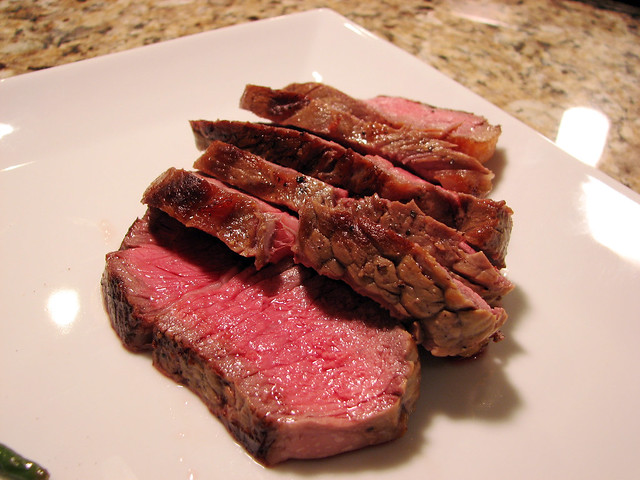 |
| American WWII Memorial, Florence |
 |
| Perseus, Viale don Giovanni Manzoni, near Piazza del Libertà, Florence, Italy |
 |
| My mom and Uncle B at Perseus |
 |
| One of the many butcher stands in Il Mercato Centrale -the covered market in Florence (notice the Bistecca alla Fiorentina to the left!) |
How to Choose the Perfect Steak and Look Like You Know What You're Doing.
Where is my meat from?
 |
| Beef cuts by muscle region |
 |
| Specific Cuts & Common Names by Muscle Region |
What are the most popular cuts of steak?
What makes them unique and preferred over another cut?
What's the best way to cook them?
Filet MignonThe Filet Mignon cut comes from the TENDERLOIN of the cattle, a small internal muscle in the cattle that is practically never used. Therefore, this is the leanest and most tender cut of beef; it practically melts in your mouth. The Filet Mignon has less marbling than rib cuts (more towards the center of the cattle), but marbling = flavoring. Although it is incredibly tender and renowned for its decadence, its lack of flavoring leads to a Filet Mignon often being accompanied by a sauce, wrapped in bacon, or sometimes even a mushroom au jus. Since the tenderloin is such a small muscle, and the Filet is always high in demand, they're typically priced pretty high. It takes to marinade extremely well, so limit the marination time and grilling time. It's best enjoyed medium rare (my favorite!) because over-cooking it will definitely dry it out.
New York Strip Steak
The Boneless Strip Steak (often referred to as a New York Strip Steak) is much more marbled than the Filet Mignon, making it more flavorful and still remain tender, making it one of the most popular cuts in America. This steak is cut from the STRIP LOIN (hence Strip Steak), and since the Strip Loin is a larger muscle, this cut is typically about 12 ounces! The strip marinates easily and it only enhances its natural abundant flavor. I like a New York Strip grilled, which is how it's most often served, and cooked between rare and medium to keep the moisture. It's more reasonably priced and makes it a great choice for everyday grilling and more casual family meals.
T-Bone & Porterhouse
If you put the 2 previous cuts of steak together (Filet + Strip) and keep the T-Shaped Bone separating the two, you have a T-Bone Steak. A T-Bone and Porterhouse are quite similar, but if you know what to look for, you can tell the difference. If the Filet is somewhat smaller than the strip, it's a T-Bone. If the Filet is bigger and nearly the same size as the strip, you have a Porterhouse. The cut is from a combination of the TENDERLOIN and the STRIP LOIN resulting in the Filet and strip, respectively. These are both great cuts to throw on the grill; just know that the Tenderloin will cook slightly faster than the strip and the beef closest to the bone will be rarer than the rest of the steak. If you are grilling, use the hotter edge of the grill to cook the strip and the cooler edge (relatively) for the Filet to even things out a bit.
 |
| T-Bone |
 |
| Porterhouse |
Ribeye
Sometimes called a Cowboy Steak, named for its boldness, style, and amazing flavor, a Ribeye cut with the bone-in is a treat! The Ribeye cut is one of the most marbled cuts of steak, but is less lean than the Filet; these characteristics make it an exceptionally juicy and flavorful cut. This cut is from the beef RIB and many steak lovers say this is their preferred cut. Ribeye is at its best when it is grilled on high and cooked between rare and medium, while still retaining moisture and its juices. A Ribeye is a perfect, hearty cut for a football tailgate or to impress neighbors and friends at a backyard cookout. AND the prices are pretty reasonable.
Sirloin
The Sirloin cut is the MOST boldly flavored. The Sirloin muscle is worked more in comparison to the other muscles cuts of steak are from. In general, it is less tender because of its workload, but if you choose a TOP SIRLOIN you'll get the best of all cuts. The top sirloin is more tender than cuts from the BOTTOM SIRLOIN, and cuts from both are moderately priced. The Top Sirloin cut retains its flavor and is still fairly tender, making it perfect for large family gatherings and grilling at cookouts. It is best to marinate a Sirloin for a few hours prior to cooking for even more flavor, but don't cook a sirloin cut past medium because it will lose both of its positive qualities.
So now you know about 5 of the most common cuts of steak and where they come from. But I keep talking about the best temperatures for steaks to be cooked to... now what would a rare steak look like compared to a medium steak?
And now you have some understanding of steak cuts, terms, and what they all mean. But what does that all matter if you don't know what to do with it? Here's a GREAT article from the UK Telegraph on How to Cook the Perfect Steak. Great steak recipes coming up soon...
Here's to Happy Grilling and Happy Taste Buds!
Cheers!






No comments:
Post a Comment